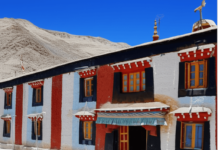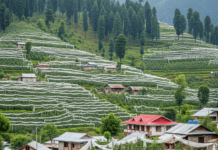Himachal Pradesh has a long and rich historical background. It was home to early communities like the Kols, Kiratas, and Nagas. The region came under the influence of various rulers during the Mauryan, Gupta, and Mughal eras. Following India’s independence, several princely hill states were united to form Himachal Pradesh, which was declared a Union Territory in 1956. Finally, on 25th January 1971, it became the 18th state of India with full statehood status. On this page, we have provided Himachal Pradesh History Questions and Answers that may help you understand the historical background of the state.
When did Himachal Pradesh become a full-fledged state of India?
Himachal Pradesh was granted complete statehood on 25th January 1971. It was the 18th state of India, and this day is celebrated as Statehood Day every year. Dr. Yashwant Singh Parmar played a major role in achieving this.
Who was the first Chief Minister of Himachal Pradesh?
Dr. Yashwant Singh Parmar, regarded as the architect of modern Himachal Pradesh, served as its first Chief Minister. He played a key role in bringing together the hill regions and was instrumental in securing full statehood for the state.
Who is called the “Pahari Gandhi” and why?
Baba Kanshi Ram earned the title of ‘Pahari Gandhi’ for his unwavering dedication to India’s freedom struggle, especially in the hilly regions of Himachal Pradesh. Deeply inspired by Mahatma Gandhi, he adopted non-violent methods and wore only black clothes as a mark of protest after Bhagat Singh’s execution. His fearless voice became a symbol of resistance in the hills.
What is the importance of the year 1948 in Himachal’s history?
In 1948, the 30 princely states of Himachal were joined to form the Chief Commissioner’s Province of Himachal Pradesh. This was the first step towards bringing the hill states together after independence.
Who founded the Chamba kingdom, and in which century?
In the 10th century AD, Raja Sahil Varman established the kingdom of Chamba. As part of his efforts to strengthen the kingdom, he moved the capital from Brahmpura to Chamba. He also named the newly established town after his beloved daughter, Champavati, leaving a lasting legacy in the region.
What was the ancient name of Kangra, and what is it famous for?
In ancient times, Kangra was called Nagarkot. The region is renowned for the Kangra Fort, one of India’s oldest forts, and its exquisite Pahari-style miniature paintings.
Which ancient Community was the earliest known inhabitant of Himachal Pradesh?
The Kol (or Munda) Community is considered one of the earliest inhabitants of the Himachal region. They were followed by communities like the Kiratas and Nagas, as per historical and mythological records.
Which emperor ruled parts of Himachal Pradesh during the Mauryan period?
In the 3rd century BCE, Emperor Ashoka governed some regions of Himachal. He introduced Buddhism in the region and built many stupas and pillars as part of his mission to spread peace.
What happened in 1956 related to Himachal Pradesh’s administrative structure?
On 1st November 1956, Himachal was made a Union Territory, and a few hilly regions from Punjab were added to it. This change helped in expanding Himachal’s geographical size.
What is the significance of Lord Dalhousie in Himachal history?
Lord Dalhousie, a British Governor-General, helped develop Shimla as a summer capital for the British. He also established Dalhousie town in the Chamba district during British rule.
What is “Dev Bhoomi” and which district is mainly called by this name?
“Dev Bhoomi” means Land of Gods, and Kullu district is widely referred to by this name. The district is home to hundreds of temples and deep religious traditions that go back centuries.
What was the role of Raja Sansar Chand in Kangra’s history?
Raja Sansar Chand, a strong ruler from the Katoch dynasty, ruled during the late 18th century. He developed the arts, especially miniature paintings, and expanded Kangra’s territory until the Gurkha invasion.
When was the Himachal Pradesh Legislative Assembly formed?
The first Himachal Pradesh Assembly was formed in 1952 with elected members. It marked the beginning of democratic governance in the state under Indian law.
Who led the political integration of Himachal’s princely states after independence?
Sardar Vallabhbhai Patel, who became India’s first Home Minister, was instrumental in the smooth and peaceful integration of the princely hill states into the Indian Union. His efforts ensured that the states, including those in the hilly regions, joined the newly independent nation without much conflict, helping to solidify India’s unity. Through his firm leadership and peaceful diplomacy, the foundation of a unified Himachal Pradesh was laid.
What is the significance of the year 1966 in Himachal’s development?
In 1966, the Punjab Reorganisation Act was passed, and hill areas like Kangra, Kullu, Lahaul-Spiti, and Shimla were merged with Himachal Pradesh. This made the state more geographically and culturally united.
Which Mughal emperor was attracted by the beauty of Himachal?
Emperor Jahangir was charmed by the natural beauty of Himachal, especially Chamba and Kangra, and he visited these regions during his rule. His admiration is mentioned in historical texts.
Which dynasty ruled the Chamba region for over 1000 years?
The Varman or Mushana dynasty ruled over Chamba for more than a thousand years. It is one of the oldest surviving dynasties in India with a long historical legacy.
What is the name of the first political organization formed in Himachal?
During the 3rd century BCE, certain regions of present-day Himachal Pradesh came under the control of Emperor Ashoka. His influence helped spread Buddhism in the area, leaving behind signs of his rule through stupas and inscriptions.
What was the political status of Himachal Pradesh before 1971?
Before 1971, Himachal was a Union Territory, formed by merging smaller hill states. It was governed directly by the central government until it gained full statehood.
Who was ruling Kullu when it was annexed by the British in 1846?
Raja Udai Singh was the ruler of Kullu during the time of the First Anglo-Sikh War. After the British emerged victorious in the war, Kullu was annexed and became a part of the British Indian Empire, marking a significant shift in the region’s history.
When did Himachal Pradesh become a Union Territory?
After the merger of 30 princely states, Himachal Pradesh was declared a Union Territory on 1st November 1956 under the States Reorganization Act. This change provided a unified administrative structure and brought the region under direct control of the central government.
When did Himachal Pradesh get full statehood?
Himachal Pradesh achieved the status of a full-fledged state on 25th January 1971. It became the 18th state of India, thanks to the continuous efforts of leaders like Dr. Y.S. Parmar, who worked hard for the political rights and recognition of the hill people.
Which ancient tribes lived in Himachal Pradesh?
In ancient times, Himachal Pradesh was inhabited by several tribes such as the Dasas, Khasas, Kiratas, and Nishadas. These tribes played an important role in shaping the early culture, traditions, and society of the region.
Name the famous old battle fought in Kangra.
One of the most memorable historical events in Himachal Pradesh was the Battle of Kangra in 1009 A.D.. During this battle, Mahmud of Ghazni, the powerful ruler from Central Asia, launched a massive attack on the famed Kangra Fort. Known for its wealth and grandeur, the fort attracted Mahmud’s attention. The battle marked a significant point in Himachal’s history, as it showcased the region’s strategic importance and the resilience of its people against foreign invasions.
Which Mughal ruler captured Kangra Fort?
Although Emperor Akbar attempted but failed to capture Kangra Fort, it was his son, Emperor Jahangir, who finally succeeded in 1620 A.D.. Jahangir’s victory marked an important chapter in Mughal expansion into the hill regions.
Which is the oldest princely state in Himachal?
Kangra is considered the oldest princely state of Himachal Pradesh, with its history dating back to ancient times. It has a rich historical background dating back to the Mahabharata era and has witnessed many battles and rulers over the centuries.
Which dynasty ruled Chamba for centuries?
The Mushana dynasty ruled the princely state of Chamba for around 1,200 years. This dynasty is credited with promoting art, culture, and architecture, which made Chamba famous for its temples and miniature paintings.
What is the significance of the year 1948 in Himachal’s history?
The year 1948 is significant because 30 princely states of the region were merged to form the Chief Commissioner’s Province of Himachal Pradesh on 15th April. It marked the first step towards administrative unification after India’s independence.
Who is remembered as the ‘Lion of Kangra’?
Raja Sansar Chand is known as the ‘Lion of Kangra’ because of his great bravery and strong leadership. He ruled the Kangra kingdom during the late 18th and early 19th centuries. Under his rule, Kangra became very powerful, and its territory expanded a lot. Raja Sansar Chand is remembered for his love for art, culture, and for building strong defenses for his kingdom. His fearless nature and smart governance made him one of the most respected rulers in the history of Himachal Pradesh.
Who called the Gurkhas to attack Kangra?
During Raja Sansar Chand’s expansionist rule, some of his rival rulers and enemies felt threatened. They sought help from the Gurkhas of Nepal, who later invaded Kangra and parts of Himachal Pradesh in the early 19th century.
When was the Gurkha War fought in Himachal?
The Gurkha War, also known as the Anglo-Gurkha War, was fought between 1814 and 1816. This war finally ended the Gurkhas’ expansion into Himachal Pradesh and nearby areas.
What was the Punjab Hill States Agency?
The Punjab Hill States Agency was a special administrative body set up by the British government. Its main purpose was to manage and supervise the small princely states located in the hills of Punjab and parts of present-day Himachal Pradesh. Created to maintain better control over these scattered hill states, the agency helped the British collect revenue, settle disputes, and maintain law and order. It played an important role in connecting these small kingdoms with the larger British Empire until India’s independence.
What was the Mandi conspiracy?
The Mandi conspiracy took place in 1914–1915. It was a secret movement started by young freedom fighters from Mandi to revolt against British rule. Though it was not very successful, it showed the rising spirit of patriotism in Himachal.
What was the capital of Bushahr State?
Rampur was the capital of the princely state of Bushahr. It became an important trade center connecting the Indian plains to Tibet through ancient trade routes.
Which historical treaty ended Gurkha dominance in Himachal?
The Treaty of Sugauli (1816) ended Gurkha rule in Himachal Pradesh, restoring peace to the region.








